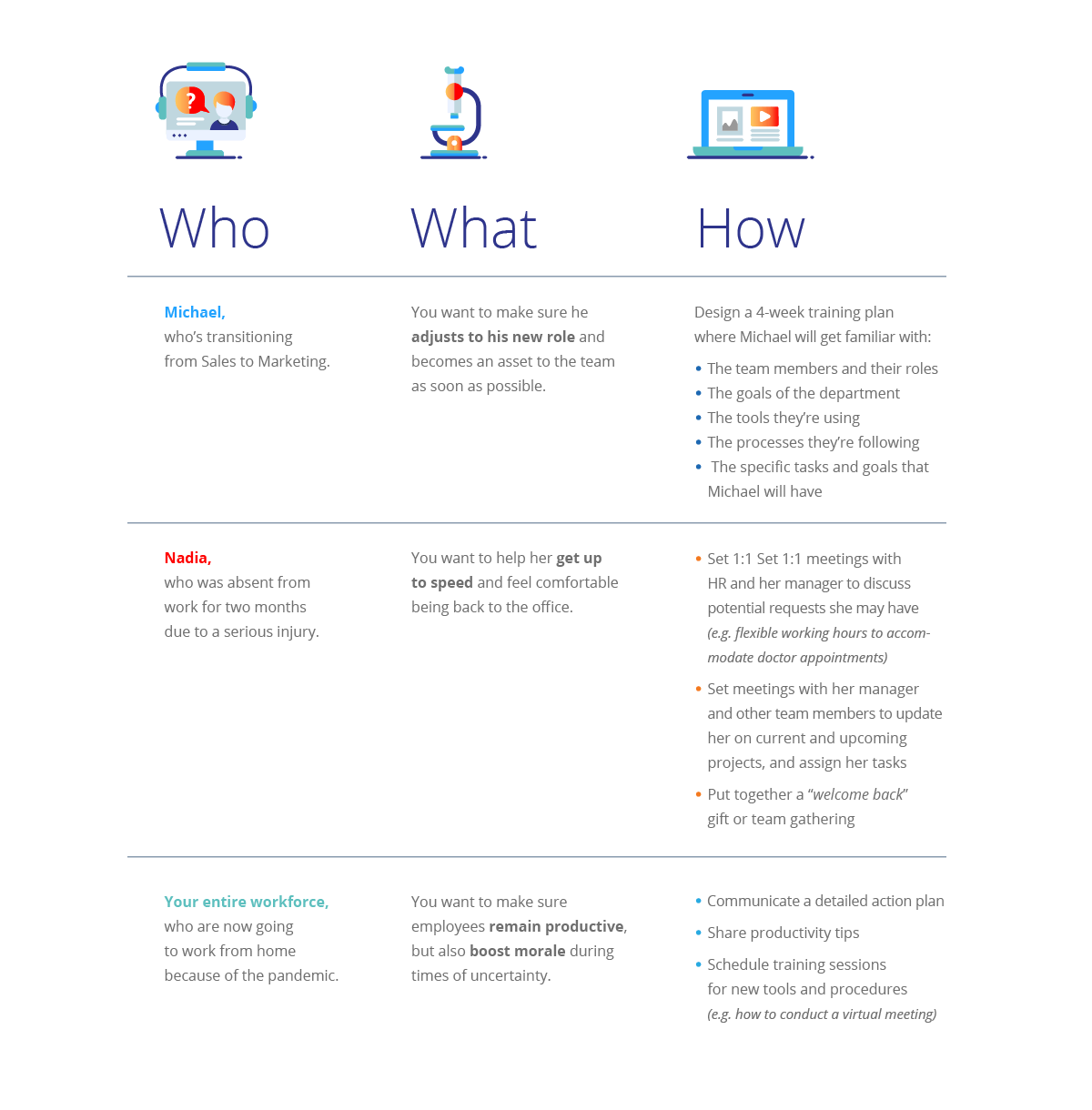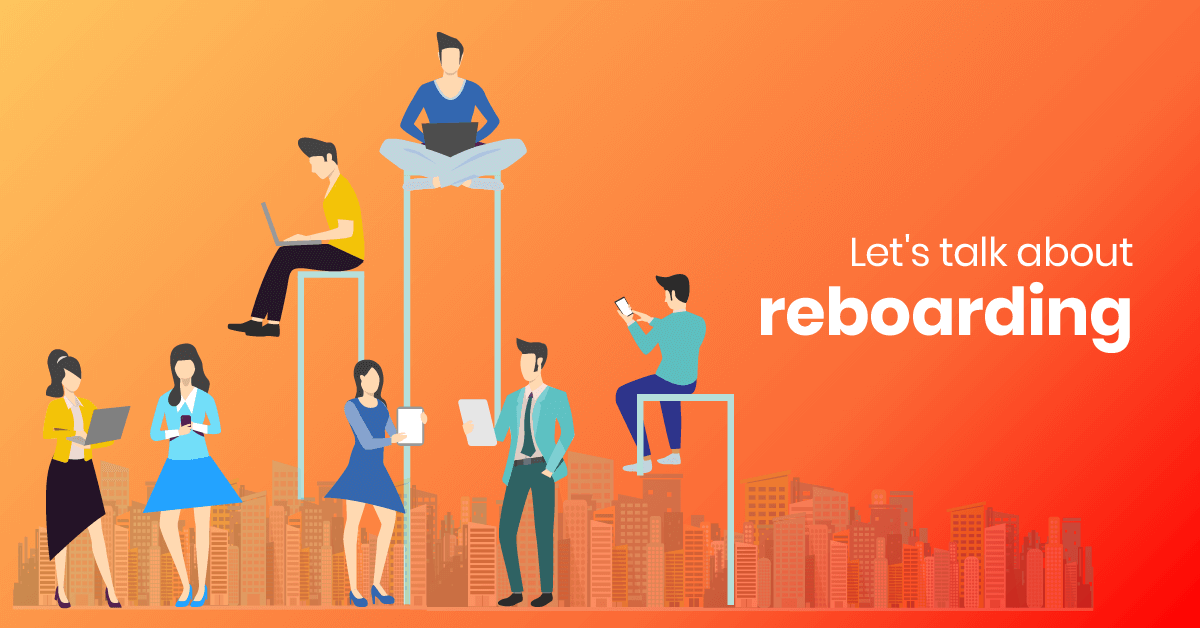The usual office tour? Check.
A quick presentation of the history and the mission of the company? Check.
Lunch break to introduce her to the team? Ch… Wait, what? Suddenly, you get a weird déjà vu.
All this seems too familiar. Oh yes! How could you have forgotten? Isabelle used to work here about a year ago on a fixed-term contract. And now she’s back for a full-time job.
So, what do you do? Do you pretend it has never happened before and give her the regular “first-day onboarding plan” or do you skip all that and ask her to roll her sleeves up as soon as she enters the office? How do you welcome a new employee, if they’re not exactly… “new”?
This is what reboarding is about. You can’t onboard the same employee twice — but you can reboard them.
What is reboarding?
Reboarding is short for re-onboarding. It involves all the activities you do in order to set an employee up for success when they re-join your company or when the work conditions have significantly changed. For example, you might want to reboard employees when:
- You reopen your offices after a lockdown or temporary business shutdown
- Employees return to work after taking a long-term leave (e.g. parental or sabbatical leave)
- You rehire employees who used to work at your company in the past (also known as “boomerang” employees)
- Employees have transitioned to a new role within the company
You may have noticed that some cases refer to one employee who returns back to work, while others refer to all or a large number of current employees. A most recent example of the latter is the COVID-19 outbreak, which has forced many companies to shift their way of working, either when they opened up their physical offices or stores, or when they transitioned to fully or semi-remote work.
What’s common in all these scenarios is the need for re-onboarding employees and making sure they have everything they need to be productive.
Reboarding vs. onboarding: What’s the difference?
Back to our story, it makes no sense for Isabelle to go through the exact same onboarding process she went through a year ago. She already knows the history and the mission of the company and the office spaces haven’t changed.
What may have changed, though, are the recent accomplishments and the future goals of the company. So, Isabelle’s reboarding plan could include an update of what the company has achieved, what they want to achieve, and what her part will be in that. Isabelle doesn’t have to formally meet her colleagues. She can just be introduced to new employees she didn’t meet before and have an informal catch-up meeting with her team.
The difference between onboarding and reboarding is that the latter doesn’t have to be as exhaustive. While both of them aim to get employees up to speed, reboarding is a more targeted onboarding process. When you reboard employees, you touch base on things that have changed, or on procedures, policies, and tasks your new-ish hire is not familiar with.
Why you need to reboard employees
Is reboarding so important that we need to have a special name for it? It is if you want to give employees a warm welcome (back) and motivate them from day one.
From a productivity standpoint: You want employees to get up to speed fast. Through reboarding, you can explain what’s being expected both from a team and individual perspective, and answer any questions they may have. You can’t assume they need no guidance just because they’ve been there before.
Besides, you want to make sure all employees are up-to-date with current policies and practices. Between her last day at your company a year ago and today, which is Isabelle’s second first day at the office, some things must have changed in the way you work. For example, you may now use a task management tool to request a project from a colleague instead of doing that verbally. Reboarding is the perfect time to inform Isabelle about that change in order to avoid potential collaboration or productivity hiccups.
From an emotional standpoint: Reboarding is a great way to increase employee engagement. Returning employees will reconnect with the company culture, understand how they’ll contribute to business success, and get a sense of belonging.
Especially if it’s been a while since they were working with you, they may feel a bit uncomfortable. Think about a new parent who might feel they’ve been “out of their game” during their absence. Or, those who have to return to the office in the midst of a pandemic, while they try to adjust to social distancing guidelines. For different reasons, returning employees might need psychological support and a small or large boost of confidence.
How to reboard your employees right
The way you welcome back and train your staff will differ depending on why you need to reboard employees in the first place. However, there is a step-by-step approach you can follow every time and adjust your plan accordingly.
Build your reboarding plan by answering:
- Who you need to reboard (and why)
- What you want to achieve
- How you’re going to do that
Let’s see a few examples in the following table:

As you can tell from these examples, your starting point is “who”, because this also explains the need for reboarding.
The “what” is your statement, or in other words, the goal of your reboarding process. Here, you need to get more specific about what you’re looking to achieve with this plan. It can help you to craft your statement, if you try to complete the sentence: “By the end of reboarding, I want my employees to have learned/feel…”
And then, the “how” includes all the steps you’re going to take to achieve your “what”. It’s the actual execution of your reboarding plan. At this point, it’s best to set a timeframe, and assign specific tasks to team members.
Depending on the situation you’re facing, your reboarding plan could be a matter of a couple of days or last for months. In Nadia’s example, reboarding includes two meetings that will take place on her first day back at work, one “welcome back” lunch with her team again during her first day, and perhaps a check-in meeting a week later.
But reboarding for employees who start working from home because of COVID-19 or go back to the office in the midst of the pandemic, is a more complex process. Here’s a sample COVID-19 reboarding plan that you can adjust and use at your company whether all or some of your employees return to the office.
Reboarding checklist: the business response to COVID-19
1. Before returning to the office
- Prepare useful material: Write down FAQs, and cybersecurity guidelines, so that employees can get answers quickly.
- Check and make sure you comply with your local regulations: You need to know, for example, how many people can be in the same workspace, whether it is mandatory to wear masks, and what to do in case someone tests positive.
- Rethink employee benefits and perks: Consider offering food gift cards instead of having in-house catering or reimburse parking spots so employees don’t have to use public transport.
- Sanitize the office: Also, schedule for regular cleaning according to safety guidelines.
- Adjust seating areas and common rooms: Make sure that desks have the appropriate distance between each other and restrict access to rooms where it’s not possible to maintain safe distances.
- Order personal hygiene products: For example, hand sanitizers, masks, gloves, thermometers, and other useful collateral (e.g. posters and stickers to remind employees to keep a distance).
- Craft and share new policies: Make sure to update your sick leave, visitors, and travel policies.
2. When you return to the office
- Inform employees about changes: Schedule a company-wide virtual meeting and share any updates you have through email, as well.
- Schedule training sessions for new tools: In case you introduced new tools and new ways to collaborate, train employees so they can make best use of them.
- Set clear expectations of precautionary measures: Reassure employees about the measures you take, but also make sure they’re aware of what they should be doing to maintain a safe work environment.
- Adjust and communicate business objectives: It’s possible that your priorities as a business have changed during these times, so keep everyone in the loop, especially those who work in public-facing roles.
- Open up communication lines: Clarify how you’ll update employees but also where they should go if they have a question.
- Set a good example: Ask senior management to do the same, as well.
- Schedule virtual “team gatherings”: Boost the team spirit and encourage work-free discussions, e.g. on a dedicated Slack channel.
- Get feedback from your employees: Check in on your teams regularly to make sure you’re doing everything you can to keep them productive and motivated.

Making your employee reboarding a success
Whether it’s your response to the COVID-19 pandemic or another reason why you’re reboarding and retraining your employees, here are a few pro tips to help you out:
Reboarding is not a one-time event
No matter how quick your process is, make sure to follow up with employees after some time to check whether they’re fully onboarded. You could get feedback from their team leaders, too, and assign additional training if necessary.
Don’t rush the process
Just because employees are already familiar with some aspects of your company, it doesn’t mean they won’t need time to process new information. Try not to overwhelm them with training courses and presentations; instead, build a training schedule that allows them to practice what they learn.
But don’t make it too long, either
For example, if you rehire employees, remove all the fluff from your onboarding presentations and focus on what’s new. In case you have to work remotely because of COVID-19, don’t build a comprehensive guide on remote work. Opt for short training courses with useful work from home productivity tips.
Be empathetic
Reboarding is about training your employees and equipping them with necessary skills and knowledge. But this goes way beyond ticking boxes. The need for reboarding is the result of a change and, whether it’s a positive one (e.g. the transition to a new role within the company), change oftens brings up feelings of anxiety or discomfort. So, be close to your employees and get them ready both practically and emotionally.
Invest in virtual tools
When it comes to COVID-19, digital tools are always preferred for training as they remove the need for physical presence. Besides that, though, online training software and virtual communication channels allow returning employees to get updates and answers quickly.
Conclusion
Instead of spending time to go through information they already know but might need a refresh, you could, for example, store useful documents on your corporate intranet and build short, digestible videos and presentations. This way, employees can review company guides and policies at their own convenience, and get ready to take on their new tasks. Because, remember, that’s the ultimate goal of reboarding your employees: to set them up for success and watch them thrive in the workplace (again).



